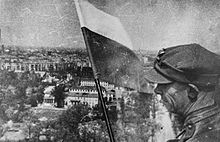Berlin Victory Column
Siegessäule | |
 | |
 | |
| 52°30′52″N 13°21′0″E / 52.51444°N 13.35000°E | |
| Location | Berlin, Germany |
|---|---|
| Height | 67m |
| Beginning date | 1864 |
| Completion date | 1873 |





The Victory Column (German: Siegessäule pronounced [ˈziːɡəsˌzɔɪ̯lə] , from Sieg 'victory' + Säule 'column') is a monument in Berlin, Germany. Designed by Heinrich Strack after 1864 to commemorate the Prussian victory in the Second Schleswig War, by the time it was inaugurated on 2 September 1873, Prussia had also defeated Austria and its German allies in the Austro-Prussian War (1866) and France in the Franco-Prussian War (1870–71), giving the statue a new purpose. Different from the original plans, these later victories in the unification wars inspired the addition of the bronze sculpture of Victoria, the Roman goddess of victory, 8.3 metres (27 ft) high, designed by Friedrich Drake, giving the victory column its current height of 67m.[1][2]
Berliners have given the statue the nickname Goldelse, meaning something like "Golden Lizzy", named after an 1866 novel by E. Marlitt and its heroine.[3] The Victory Column is a major tourist attraction in the city of Berlin. Its viewing platform, for which a ticket is required, offers a view over Berlin.
History, design, and influences
[edit]Design
[edit]The base consists of polished red Swedish granite, measuring 18.8 meters square and 7.2 meters high. The base contains four bronze reliefs depicting scenes from the three victories. Measuring 12 meters wide and 2 meters high, they were designed by Moritz Schulz, Karl Keil, Alexander Calandrelli, and Albert Wolff. Upon the base is a round hall with 16 granite columns measuring 4.7 meters high. Along the hall's circumference is a glass mosaic designed by Anton von Werner. Four sandstone columns rise above this hall, the first three containing 20 gilded gun barrels each, 12 pounders from the Danish victory, 8 pounders from the Austrian victory, and 4 pounders from the French victory. On top of the fourth sandstone column resides the 8.52 meter tall gilded bronze victory.[1]
The relief decoration was removed in 1945. It was restored for the 750th anniversary of Berlin in 1987 by the French president at that time, François Mitterrand.[1]: 114–115
Locations
[edit]The Victory Column originally stood in Königsplatz (now Platz der Republik). In 1938/1939, as part of the preparation of the monumental plans to redesign Berlin into Welthauptstadt Germania, the Nazis relocated the column to its present site at the Großer Stern (Great Star). At the same time, the column was augmented by another 6.5 metres, giving it its present height of 66.89 metres. The monument survived World War II without much damage. Surrounded by a street circle, the column is also accessible to pedestrians through four tunnels, according to plans by Albert Speer. A spiral staircase leads to a viewing platform under the statue.[1]: 99–107
Historical significance
[edit]During the Battle of Berlin of 1945, Soviet troops nicknamed the column "the Tall Woman".[4] Polish Army troops, fighting alongside their Soviet allies, hoisted the Polish flag on the column on 2 May 1945 at the end of the Battle in Berlin. This is celebrated yearly as Polish National Flag Day.
During the allied victory parade in 1945, the French tricolour was raised atop the column on the statue by French troops.[5]
It served as the location for Barack Obama's speech in Berlin as a US presidential candidate during his visit to Germany on 24 July 2008.[6][7]
In popular culture
[edit]In Wim Wenders' Wings of Desire (1987), the column is one of many high places in the city where angels sit and look down.[8]
The golden statue atop the column, cast in 1873 by the Aktien-Gesellschaft Gladenbeck foundry in Berlin,[9][10] was featured in the music video to U2's 1993 "Stay (Faraway, So Close!)", an homage to Wings of Desire.
During the years of the techno Love Parade, the column was a meeting point where large numbers of people danced together.[11]
The Berlin queer monthly magazine Siegessäule was named after the monument, founded 1984 as a gay publication.[12][13] The Berlin Pride (CSD parade) usually includes the column on its route for the symbolism.[14]
The monument is one of the many landmarks visited in the "Berlin Byways" course in Mario Kart Tour (since 2021), and later Mario Kart 8 Deluxe (since 2022).[15]
References
[edit]- ^ a b c d Alings, Reinhard (2000). Die Berliner Siegessaule: Vom Geschichtsbild zum Bils der Geschichte. Berlin: Parthas Verlag GmbH. pp. 35–51. ISBN 9783932529719.
- ^ Braun, Matthias (2000). Die Siegessaule. Berlin: Berlin Edition. p. 11. ISBN 3814800265.
- ^ Berlin Tourist Information – Tiergarten Archived 22 June 2008 at the Wayback Machine
- ^ Beevor, A (2003), Berlin: The Downfall 1945, Penguin Books, p. 395
- ^ ECPAD - Troupes françaises défilant à Berlin
- ^ Whitesides, John (25 July 2008). "Obama's foreign trip: Mission accomplished". Reuters.
- ^ Borcholte, Andreas (20 July 2008), "Sieg der Säule", Spiegel
- ^ Nachrichten, BerlinOnline.de, 2012, archived from the original on 15 August 2009, retrieved 26 July 2008
- ^ "Biography: Hermann Gladenbeck (1827-1918)". toboganantiques.com. Archived from the original on 18 June 2015. Retrieved 18 June 2015.
- ^ "Oscar Gladenbeck (1850-1921)". ISSUU.com. 6 April 2013. Retrieved 18 June 2015.
- ^ Berlin Life: 'The Death of Dance?' A history of the Berlin Love Parade, Berlin-Life.com, 2007, retrieved 21 July 2020
- ^ "Die "Siegessäule" wird 30". Der Tagesspiegel Online. 15 November 2014.
- ^ TBS-Monatsinfo (Treff Berliner Schwulengruppen) (10 February 1984). "Gemeinsames". Record of TBS: Top 12 – via Archiv Gay Museum Berlin.
- ^ "Demo | Route 2019".
- ^ Mario Kart Tour - Berlin Byways, 9 February 2022

